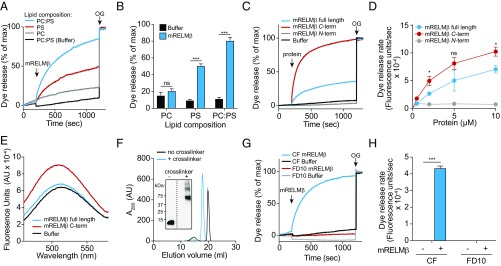Fig. 2.
RELMβ binds to negatively charged lipids and forms a multimeric pore in membranes. (A) mRELMβ disrupts carboxyfluorescein (CF)-loaded unilamellar liposomes containing the negatively charged lipid phosphatidyl serine (PS), but not liposomes composed of the zwitterionic lipid phosphatidylcholine (PC). Liposomes were treated with 5 μM mRELMβ, and dye efflux was monitored over time. The 1.0% octyl glucoside (OG) was added toward the end to disrupt remaining liposomes. Dye efflux is expressed as a percentage of maximal release by OG. (B) Means ± SD from three independent replicates of the experiment shown in A. (C) mRELMβ membrane-disrupting activity is confined to the C terminus. PC:PS liposomes (100 µM) were incubated with 5 μM full-length mRELMβ or the mRELMβ N or C terminus. (D) Initial rate of liposome dye efflux as a function of mRELMβ concentration. Assays were done in triplicate, means ± SD are shown, and statistical significance was calculated relative to the mRELMβ C terminus. (E) The C-terminal portion of mRELMβ binds lipid. The 5 μM full-length mRELMβ or the mRELMβ N or C terminus was added to liposomes incorporating 5% dansyl-PE, and dansyl fluorescence was monitored as measure of binding. (F and G) mRELMβ forms a multimeric complex in the presence of liposomes. Full-length mRELMβ was incubated with 100 mM PC:PS liposomes and cross-linked with bis(sulfosuccinimdyl) suberate. Cross-linked complexes were solubilized in detergent, resolved by size exclusion chromatography (F), and analyzed by Western blotting with anti-RELMβ antibody (F, Inset). mRELMβ forms a complex of ∼60–70 kDa, or roughly six to eight protein units. (G) mRELMβ forms size-selective pores in liposomes. The 10 μM full-length mRELMβ was added to 100 μM PC:PS liposomes loaded with carboxyfluorescein (CF) (∼10-Å Stokes diameter) or fluorescein isothiocyanate-dextran 10 (FD10) (∼44-Å Stokes diameter). (H) Means ± SD from three independent replicates of the experiment shown in G. Statistics were performed with Student’s t test; *P < 0.05; ***P < 0.001; ns, not significant.

